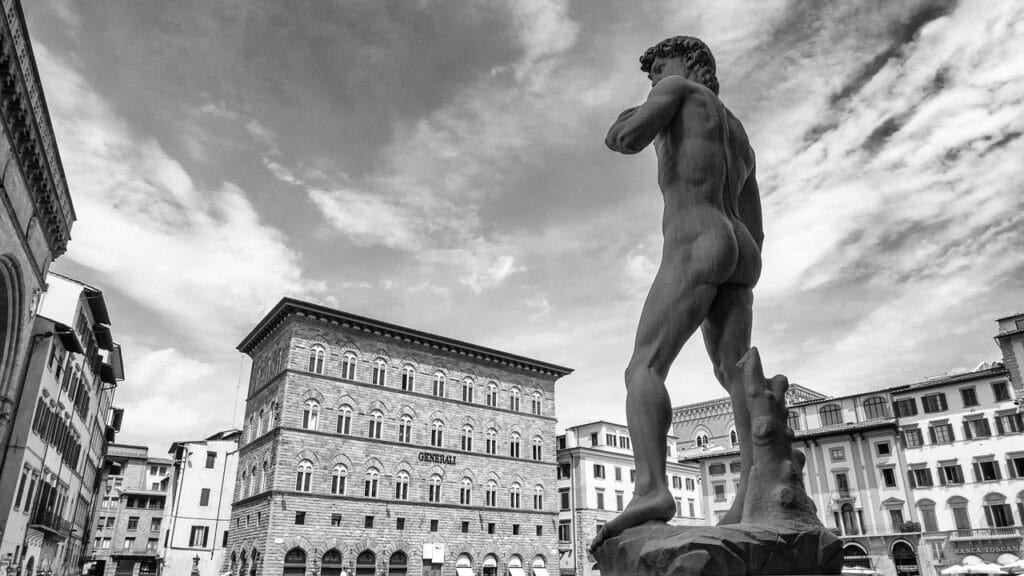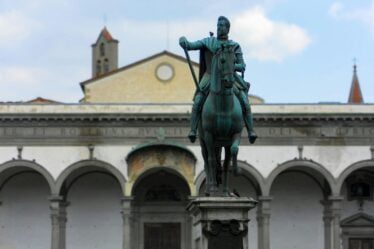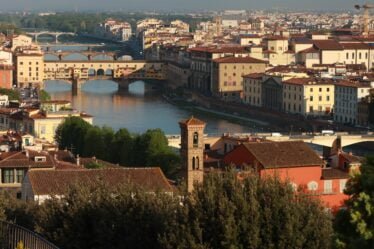

Introduction
Eternal Revenge in Marble is not just the story of a monument in Florence, but also a tale of wounded pride, bitter rivalry, and artistic revenge carved forever in stone. In the heart of Piazza San Lorenzo stands the monument to Giovanni delle Bande Nere, and while the statue itself is dignified, the details at its base hide a scandalous insult. To understand this, we need to look at the stormy relationship between Baccio Bandinelli and Baldassarre Turini.
A Sculptor with Many Enemies
Florentine sculptor Baccio Bandinelli (1493–1560) was a man of immense ambition, often seen as the rival of Michelangelo. Yet, unlike Michelangelo, he constantly struggled with criticism and envy. His temperament was fiery, and when he felt attacked, he did not hesitate to retaliate.
One of his fiercest enemies was Baldassarre Turini, a cleric close to the Medici and the papal court. Turini often ridiculed Bandinelli, belittling his talent and comparing him unfavorably with the great Michelangelo. These remarks, coming from such a powerful man, deeply wounded Bandinelli’s pride.
And so, Eternal Revenge in Marble took shape not just as a monument, but as an act of personal vendetta.
The Pig as Insult
When Bandinelli sculpted the base of the monument to Giovanni delle Bande Nere, he filled it with grotesque figures and allegorical decorations. Among these details appears the image of a pig.
At first glance, it might seem like an ordinary animal motif. However, contemporaries quickly recognized it as a caricature: the pig symbolized none other than Baldassarre Turini. In Renaissance symbolism, pigs represented greed, vulgarity, and gluttony. Associating a respected cleric with such an image was an outrageous and unforgettable insult.
Thus, Bandinelli’s anger transformed into Eternal Revenge in Marble—a permanent mockery placed in a public square, visible to all who passed by.
How Florence Reacted
Of course, word spread quickly in Florence. Those who knew about the rivalry whispered the truth behind the pig. For some, it was a brilliant strike of wit: Bandinelli had used his art to silence an arrogant cleric. For others, however, it was proof of his vindictive nature.
Even Giorgio Vasari, in his famous Lives of the Artists, criticized Bandinelli for envy and spite, suggesting that such energy would have been better spent on noble artistic pursuits. Still, the fact remained—Turini could do little. To protest openly would have meant admitting to being the pig, making him the subject of even more ridicule.
This silence ensured that Eternal Revenge in Marble achieved its purpose: it humiliated Turini in a way that was both undeniable and permanent.
Bandinelli’s Rivalry with Michelangelo
To fully understand Bandinelli’s bitterness, it is essential to consider his rivalry with Michelangelo. The two sculptors represented opposite poles of Florentine art: Michelangelo, celebrated as divine, and Bandinelli, often mocked as envious and insecure. Turini’s mockery reinforced this comparison, adding salt to an open wound.
Therefore, Bandinelli’s revenge against Turini was not only personal but also symbolic—an attempt to strike back against those who constantly placed him in Michelangelo’s shadow.
Conclusion
In the end, Eternal Revenge in Marble is more than just a monument to a Medici warrior. It is a fascinating glimpse into the passions, rivalries, and hidden messages of Renaissance Florence. Bandinelli’s pig may look like a small detail, but it embodies an artist’s anger, pride, and desire to turn insult into immortality.
Even today, visitors who pause in Piazza San Lorenzo can read this silent revenge carved in stone—proof that art in Florence was never only about beauty, but also about power, rivalry, and eternal memory.



